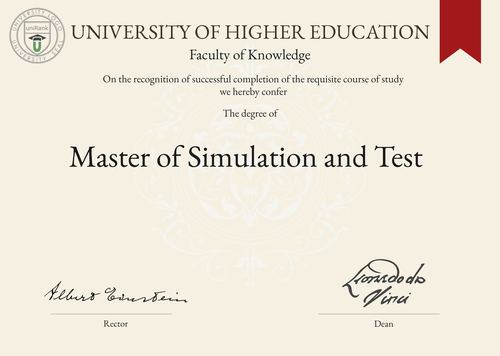
Master of Simulation and Test (MST)
Guide to Master of Simulation and Test Program/Course/Degree
Master of Simulation and Test (MST)

Program Name
Master of Simulation and TestProgram or Degree abbreviation
MSTDuration range
The duration of the Master of Simulation and Test program typically ranges from 1 to 2 years.Tuition range
The tuition fees for the Master of Simulation and Test program can vary depending on the chosen country or university. It is recommended to check with specific institutions for accurate information.Overview
The Master of Simulation and Test program is designed to provide students with advanced knowledge and skills in simulation and testing methodologies. It focuses on the application of simulation techniques and testing procedures in various industries, including engineering, manufacturing and research.Curriculum Overview by year
The curriculum of the Master of Simulation and Test program is structured to cover both theoretical and practical aspects of simulation and testing. The coursework is typically divided into different modules, which may include subjects such as: Year 1: - Introduction to Simulation and Test - Statistical Analysis for Simulation - Modeling and Simulation Techniques - Experimental Design and Analysis - Simulation Software Tools Year 2: - Advanced Simulation Methods - Reliability and Quality Testing - Simulation Optimization - Simulation in Manufacturing - Case Studies and Project WorkKey Components
The key components of the Master of Simulation and Test program include: - Understanding simulation and testing methodologies - Developing skills in statistical analysis and experimental design - Utilizing simulation software tools - Applying simulation techniques in various industries - Conducting research and case studies in simulation and testingCareer Prospects
Graduates of the Master of Simulation and Test program can pursue various career paths in industries such as manufacturing, engineering, research and consulting. They can work as simulation engineers, test analysts, quality assurance specialists, or research associates in organizations that require simulation and testing expertise.Salary Expectations
The salary expectations for professionals with a Master of Simulation and Test degree can vary depending on factors such as job role, industry and location. Generally, individuals in this field can expect competitive salaries that reflect their specialized skills and knowledge. For a more accurate understanding of salary expectations, you can utilize the Job Sites Search Engine, from our sister site jobRank, which searches over 4,600 job sites worldwide. Make sure to specify not only the job title but also the country you are interested in.Conclusions:
It is important to note that the duration, tuition fees, curriculum, key components, career prospects and salary expectations of the Master of Simulation and Test program can vary depending on the chosen country or location for studying the program, as well as the chosen university. Prospective students are advised to research and compare different institutions to find the best fit for their educational and career goals. Visitors interested in pursuing a Master of Simulation and Test degree can use the uniRank World Universities Search Engine to find universities offering this specific program anywhere in the world.World Universities Search Engine
search for Master of Simulation and Test (MST) and add the Location (country, state etc.) or specific University you are interested in studying at.
Query examples:
- Master of Simulation and Test (MST) United States
- Master of Simulation and Test (MST) United Kingdom online
- Master of Simulation and Test (MST) Australia international students
- Master of Simulation and Test (MST) University of California
- Master of Simulation and Test (MST) University of London tuition fees
- Master of Simulation and Test (MST) University of Sydney scholarships
Share Program/Course
Interesting? Share this program/course/degree info with your friends now.